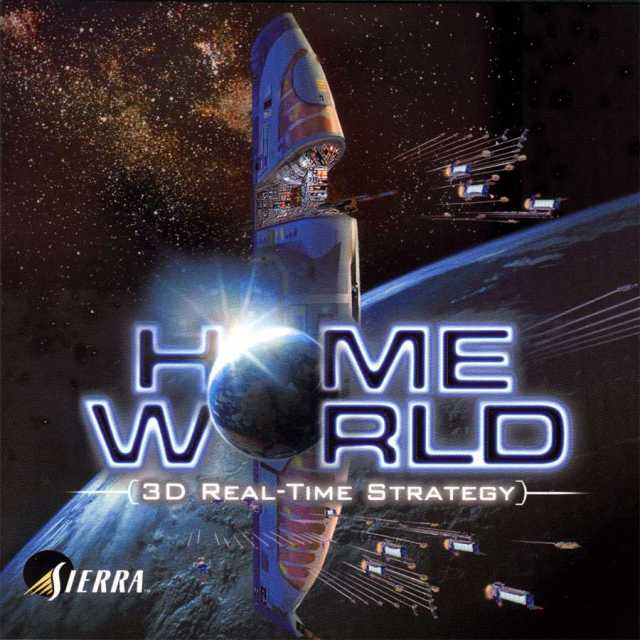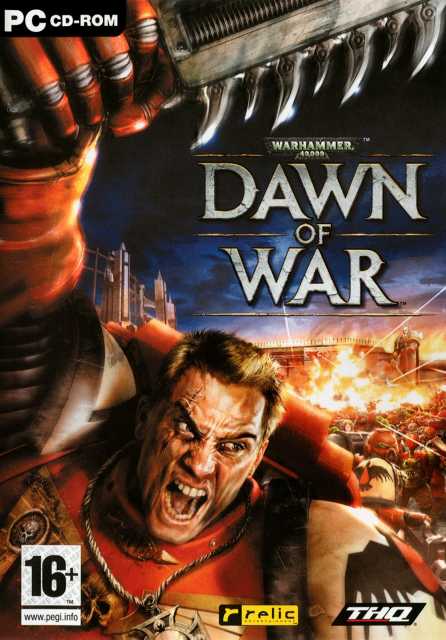Independent
Founded in 1997 by CEO Alex Garden and Luke Moloney, Relic began as a small startup in Vancouver, British Columbia. Garden bankrolled the first year of development on his credit card, until Sierra Entertainment were introduced to their Homeworld project in April of 1998 and agreed to finance the game's development. With the new financial backing, Relic immediately shifted from their old 1600 sq foot office to a much larger 12,000 sq foot facility in Vancouver's historic Yaletown district and expanded by hiring Curtis Terry as CFO and Ron Moravek as COO.
Homeworld
 Homeworld was the first fully 3-dimensional RTS.
Homeworld was the first fully 3-dimensional RTS.After glowing previews at E3 the preview year, Homeworld was released in 1999 and earned several awards, including the prestigious "Game of the Year" award from PC Gamer and IGN. The game was universally lauded for its innovative, fully 3-dimensional gameplay and large, cinematic space battles. It was also scientifically proven to be better than pants. A Homeworld spin-off, Cataclysm, was developed by Barking Dog Studios using the same engine and got an equally good critical reception.
In December 1999, Relic started working on their next project, titled Sigma: The Adventures of Rex Chance which was eventually renamed and released as Impossible Creatures by Microsoft in December 2002. An RTS at its core, players can collect and combine various animal DNA to design their own units and armies. Relic also started work on an action adventure title in the same universe but it was cancelled due to the game's disappointing sales and critical reception.
Relic's next release was the sequel Homeworld 2 in 2003, with various graphical and gameplay enhancements. Though one of the most anticipated RTS titles that year, the final game didn't receive the same level of praise as the original and many reviewers cited a lack of significant evolution over the first as its main drawback. Later in 2003, Relic released the source code to the original and also continued supporting the mod community through their Relic Developer Network.
Under THQ
Acquisition & Dawn of War
 Dawn of War shifted the focus from resource management to combat.
Dawn of War shifted the focus from resource management to combat.Relic entered a multi-property publishing agreement with THQ in April 2003 and soon announced that they were working on Warhammer 40k: Dawn of War, an RTS based on Games Workshop's Warhammer 40,000 IP. A year later in April 2004, THQ acquired Relic for close to $10 million in an all cash agreement. In October 2004, Relic crossed the 100 employees mark.
Dawn of War was released on September 20, 2004 to commercial and critical success. It innovated on the old RTS formula by cutting down on resource management, instead focusing on smaller but more powerful squad-based armies. The game was also very popular among Warhammer fans for a faithful translation of the popular franchise. Relic built on its success and developed the expansion Winter Assault, adding the Imperial Guard faction in the mix. They also released & regularly updated a mod toolset, continuing their strong support of the mod community.
In 2006, the standalone expansion Dark Crusade was released and it introduced the Tau and Necron races to the series, in addition to a tactical turn-based mechanic for the main campaign. With over 4 million sales (including the expansion packs), Dawn of War remains one of the highest selling PC games of all time. Also in 2006, Relic made their first foray into console gaming with the The Outfit for the Xbox 360. The game tried to mix squad based strategies with third person shooting but received an average critical reception.
Company of Heroes & more Warhammer
 Relic's WW-II RTS won them the 'Developer of the Year' award in 2006.
Relic's WW-II RTS won them the 'Developer of the Year' award in 2006.Using their new Essence Engine, Relic released the World War II-themed RTS Company of Heroes on Sept 11, 2006. It took the squad based mechanics from Dawn of War even further by adding additional cover mechanics and advanced physics for destructible environments. It was also one of the first games to fully integrate DirectX 10 and featured HDR and dynamic lighting. Company of Heroes' innovative gameplay & engaging main campaign won it several awards and Relic were named the 'Developer of the Year' by IGN that year.
Relic iterated on the successful formula with two standalone expansions, Opposing Fronts and Tales of Valor over the next three years. They also started work on an micro-transaction based MMO Company of Heroes Online in South Korea, but the servers were shut down after the Beta phase.
Relic's next release was 2009's Dawn of War II, which took big risks by having a more RPG-esque single player campaign. Players took control of a handful of space marines and slowly built them using talent trees and item drops. It also took several cues from the Company of Heroes series by making cover & positioning more significant during combat. The game earned mostly positive reviews, with most players praising the fast paced combat but also criticizing the lack of mission variety and multiplayer maps. An expansion, Chaos Rising, was released a year later which further built on the story & mechanics of the original, while also adding the popular Last Stand mode - a horde-mode equivalent for Warhammer champions.
In 2011, Relic released the standalone expansion Dawn of War II: Retribution which introduced 6 playable races for the single player campaign and replaced GFWL matchmaking with Steamworks for multiplayer. They also released a standalone game for Last Stand, appropriately named Last Standalone on Steam.
Relic's next release, Space Marine was their second go at console games, this time set in the Warhammer universe. Players took control of Ultramarine Captain Titus as he repeled an Ork invasion on a Forge World. Mixing third-person shooting and melee, the game was praised for its combat and but was criticized for a lack of variety in environments and its linear campaign.
Under Sega
 Sonic donning Space Marine armor drawn in Relic's kitchen blackboard.
Sonic donning Space Marine armor drawn in Relic's kitchen blackboard.On January 23, 2013 in a THQ property auction, Relic was acquired by Sega for $26.6 million.
The company's first release under Sega was Company of Heroes 2.
Relic released Dawn of War III on April 27, 2017. It brings back base building along with large elite units.
On October 21, 2017 at Gamescom it was announced that Relic are the developers of Age of Empires 4 with Microsoft Studios acting as publisher.
Log in to comment